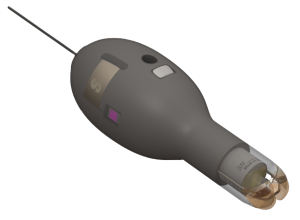The sPAT is a pop-up archival transmitting tag (PAT tag, also known as a PSAT) specifically optimized for short-term survivorship studies. The sPAT uses a suite of sensors and algorithms to monitor the status of the tagged animal for up to 60 days.

Overview
- The sPAT is very easy to deploy—can be used by recreational and commercial fishermen.
- The sPAT is attached to the fish by a tether and anchor—we provide a variety of anchors for different species.
- For convenience, tags come preconfigured and will automatically deploy when submerged in seawater. Users can optionally adjust deployment duration and release parameters if needed.
- A corrodible pin allows the release of the sPAT from the fish 30, 45, or 60 days after deployment or when certain conditions indicating the tag is no longer on a swimming fish (conditional release) are met.
- Once released from the fish, the tag floats to the surface and transmits its data to Wildlife Computers Data Portal for processing—Wildlife Computers pays for all the Argos charges.
Data Products
- Pop-up date and location via Argos
- Delta Light—changes in delta light can be an indicator of predation/ingestion
- Daily min/max depth and temperature (to confirm the tag was attached to a swimming animal)
- Time-series depth for the end of the deployment to help determine the fate of the animal.
The operational definition of “survivorship” is when the tag is still attached to a swimming animal 30 days after deployment.
User Guide/Software
This user guide gives you all the essential information needed for interacting with, configuring, and deploying this tag. It also includes instructions on how to use Tag Agent.
USB Communications Cable Driver – 29-March 2023
Driver for the Wildlife Computers USB Communications cable.
Specifications
Below are the physical specifications of the sPAT. A full description of these features is available on the downloadable sPAT Product Features (PDF).
| Attachment Type | Towed |
| Sensors | Depth, Temperature, Light |
| Depth Sensor Range | 0-1700 m, 0-2000* |
| Depth sensor Resolution | 0.5 m, 1m* |
| Depth Sensor Accuracy | +/- 1% of reading |
| Temperature Sensor Range | -40° C to 60° C |
| Temperature Sensor Resolution | 0.05° C |
| Temperature Sensor Accuracy | +/- 0.1° C |
| Light Sensor | 5 x 10-12W.cm-2 to 5 x 10-2W.cm-2 |
| Wet/Dry Sensor | Yes |
| Length (mm) | 118 mm |
| Diameter (mm) | 41 mm |
| Weight (g) | 68 g |
| Pressure Rating (m) | 2000 m |
| Operating Temperature Rating (°C) | -20° C to 50° C |
| Conductivity Operational Limits | 0.1 to 5 S/m |
| Optimal Storage Temperature range (°C) | 0° C to 5° C |
| Maximum Deployment Length | 60 Days |
*Meters of freshwater. To convert to dBar, or an approximation for meters of seawater, multiply the reported value by 0.9804
